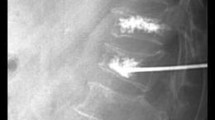Abstract
Several authors claim that vertebroplasty (PVT) is a successful technique, but long-term effectiveness is still debated. Our goal was to evaluate the effectiveness of PVT in patients with symptomatic vertebral fractures that had not responded to conservative treatment. In our centre, 624 patients with 1,253 compression fractures were treated by PVT. Imaging studies, clinical visits and short- and long-term follow-up were assessed by visual analogue scale (VAS) testing of pain. Statistical analysis was performed to evaluate pain response after PVT (paired two-tailed t-test) and to assess any differences in pain due to different lesions (ANOVA test). We found a statistically significant improvement in the patients’ quality of life, particularly in pain (P < 0.001). The average VAS value pre-PVT was 8.0 ± 2.5, which significantly dropped to 1.5 ± 0.4 by 12 months. There were no significant differences in pain response between the groups of patients with different underlying disease. There was a low complication rate in our study. PVT should be considered the treatment of choice in vertebral fractures with refractory pain. With strict evaluation of the clinical indications and subspecialised operators, long-term effectiveness is probable.






Similar content being viewed by others
References
Galibert P, Deramond H, Rosat et al (1987) Preliminary note on the treatment of vertebral angioma by percutaneous acrylic vertebroplasty. Neurochirurgie 33:166–168
Ettinger B, Black DM, Nevitt MC et al (1992) Contribution of vertebral deformities to chronic back pain and disability. The Study of Osteoporotic Fractures Research Group. J Bone Miner Res 7:449–456
Silvermann SL (1992) The clinical consequences of vertebral compression fracture. Bone 13:27–31
Turner JA, Fulton-Kehoe D, Franklin G et al (2003) Comparision of the Roland-Morris disability questionnaire and generic health status measures: a population based study of workers’ compensation back injury claimants. Spine 28:1061–1067
Jensen ME, Evans AJ, Mathis JM et al (1997) Percutaneous polymethylmethacrylate vertebroplasty in the treatment of osteoporotic vertebral body compression fractures: technical aspects. AJNR 18:1897–1904
Voormolen MH, Mali WP, Lohle PN et al (2007) Percutaneous vertebroplasty compared with optimal pain medication treatment: short-term clinical outcome of patients with subacute or chronic painful osteoporotic vertebral compression fractures. The VERTOS study. AJNR 28:555–560
Evans AJ, Jensen ME, Kip KE et al (2003) Vertebral compression fractures: pain reduction and improvement in functional mobility after percutaneous polymethylmethacrylate vertebroplasty retrospective report of 245 cases. Radiology 226:366–372
Diamond TH, Champion B, Clarck WA (2003) Management of acute osteoporotic vertebral fractures: a nonrandomized trial comparing percutaneous vertebroplasty with conservative therapy. Am J Med 114:257–265
Anselmetti GC, Corrao G, Monica PD et al (2007) Pain relief following percutaneous vertebroplasty: results of a series of 283 consecutive patients treated in a single institution. Cardiovasc Intervent Radiol 30:441–447
Mathis JM, Barr JD, Belkoff SM et al (2001) Percutaneous vertebroplasty: a developing standard of care for vertebral compression fractures. AJNR 22:373–381
Masala S, Cesaroni A, Sergiacomi G et al (2004) Percutaneous kyphoplasty: new treatment for painful vertebral body fractures. In Vivo 18:149–153
Shen MS, Kim YH (2006) Vertebroplasty and Kiphoplasty. Treatment techniques for managing osteoporotic vertebral compression fractures. Bull NYU Hosp Jt Dis 64:106–113
Mcgraw JK, Gardella I, Barr JD et al (2003) Society of international radiology quality improvement guidelines for percutaneous vertebroplasty. J Vasc Intervent Radiol 14:311–315
Kobayashi K, Shimoyana K, Nakamura K et al (2005) Percutaneous vertebroplasty immediately relieves pain of osteoporotic vertebral compression fractures and prevents prolonged immobilization of patients. Eur Radiol 15:360–367
Alvarez L, Perez-Higueras A, Quinones D et al (2003) Vertebroplasty in the treatment of vertebral tumours: postprocedural outcome and quality of life. Eur Spine J 12:356–360
Grados F, Depriester C, Cayrolle G et al (2000) Long-term observations of vertebral osteoporotic fractures treated by percutaneous vertebroplasty. Rheumatology 39:1410–1414
Layton KF, Thielen KR, Koch CA et al (2007) Vertebroplasty, first 1000 levels of a single center: evaluation of the outcomes and complication. Am J Neuroradiol 28:683–689
Kayanja MM, Schlenk R, Togawa D et al (2006) The biomechanics of 1, 2 and 3 levels of vertebral augmentation with polymethylmethacrylate in multilevel spinal segments. Spine 31:769–774
Choe DH, Marom EM, Ahrar K et al (2004) Pulmonary embolism of polymethyl methacrylate during percutaneous vertebroplasty and kyphoplasty. AJR 183:1097–1102
Ratliff J, Nguyen T, Heiss J (2001) Root and spinal cord compression from methylmethacrylate vertebroplasty. Spine 26:300–302
Moreland DB, Landi MK, Grand W (2001) Vertebroplasty: techniques to avoid complications. Spine J 1:66–71
Mousavi P, Roth S, Finkelstein J et al (2003) Volumetric quantification of cement leakage following percutaneous vertebroplasty in metastatic and osteoporotic vertebrae. J Neurosurg 99:56–59
Ramos L, de Las Heras JA, Sanchez S et al (2006) Medium-term results of percutaneous vertebroplasty in multiple myeloma. Eur J Haematol 77:7–13
Barragan-Campos HM, Vallee JN, Lo D et al (2006) Percutaneous vertebroplasty for spinal metastases: complications. Radiology 238:354–362
Krauss M, Hirschfelder H, Tomandl B et al (2006) Kyphosis reduction and the rate of cement leaks after vertebroplasty of intravertebral clefts. Eur Radiol 16:1015–1021
Hulme PA, Krebs J, Ferguson SJ et al (2006) Vertebroplasty and kyphoplasty: a systematic review of 69 clinical studies. Spine 31:1983–2001
Syed MI, Patel NA, Jan S et al (2005) New symptomatic vertebral compression fractures within a year following vertebroplasty in osteoporotic women. Am J Neuroradiol 26:1601–1604
Voormolen MH, Lohle PN, Juttmann JR et al (2006) The risk of new osteoporotic vertebral compression fractures in the year after percutaneous vertebroplasty. J Vasc Interv Radiol 17:71–76
Author information
Authors and Affiliations
Corresponding author
Rights and permissions
About this article
Cite this article
Masala, S., Mastrangeli, R., Petrella, M.C. et al. Percutaneous vertebroplasty in 1,253 levels: results and long-term effectiveness in a single centre. Eur Radiol 19, 165–171 (2009). https://doi.org/10.1007/s00330-008-1133-4
Received:
Revised:
Accepted:
Published:
Issue Date:
DOI: https://doi.org/10.1007/s00330-008-1133-4




